Sena dynasty
The Sena dynasty was a Hindu dynasty during the early medieval period on the Indian subcontinent, that ruled from Bengal through the 11th and 12th centuries.[3] The empire at its peak covered much of the north-eastern region of the Indian subcontinent. The rulers of the Sena Dynasty traced their origin to the south Indian region of Karnataka.[4]
Sena Empire | |||||||||||||||
|---|---|---|---|---|---|---|---|---|---|---|---|---|---|---|---|
| 1070 CE–1230 CE | |||||||||||||||
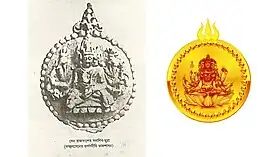 Coat of Arms of Sena dynasty during Laxmana Sena's reign
Copperplate (left) and digitalised (right) | |||||||||||||||
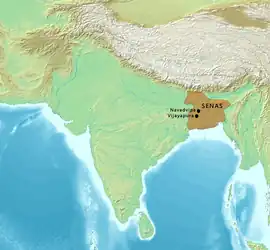 Map of the Sena Empire.[1] | |||||||||||||||
| Capital | Gauda, Bikrampur, Nabadwip, Lakhnauti, Chandrabhoga Gadhi, Balirajgarh, Vijaynagar | ||||||||||||||
| Common languages | Sanskrit, Bengali | ||||||||||||||
| Religion | Hinduism | ||||||||||||||
| Government | Monarchy | ||||||||||||||
| Maharaja (King) | |||||||||||||||
• 1070–1095 CE | Samanta Sena | ||||||||||||||
• 1095–1096 CE | Hemanta Sena | ||||||||||||||
• 1096–1159 CE | Vijaya Sena | ||||||||||||||
• 1159-1179 CE | Ballala Sena | ||||||||||||||
• 1179-1204 CE | Lakshmana Sena | ||||||||||||||
• 1204-1225 CE | Vishvarupa Sena | ||||||||||||||
• 1225–1230 CE | Keshava Sena | ||||||||||||||
• | Surya Sena[2] | ||||||||||||||
• | Narayana Sena[2] | ||||||||||||||
• | Laksmana Sena ।।[2] | ||||||||||||||
| Historical era | Middle Kingdoms of India | ||||||||||||||
• Established | 1070 CE | ||||||||||||||
• Disestablished | 1230 CE | ||||||||||||||
| |||||||||||||||
| Sena dynasty 1070 CE–1230 CE | ||||||||||||||
|---|---|---|---|---|---|---|---|---|---|---|---|---|---|---|
|
||||||||||||||
The dynasty's founder was Samanta Sena. After him came Hemanta Sena, who usurped power and styled himself king in 1095 AD. His successor Vijaya Sena (ruled from 1096 AD to 1159 AD) helped lay the foundations of the dynasty and had an unusually long reign of over 60 years. Ballala Sena conquered Gaur from the Pala, became the ruler of the Bengal Delta, and made Nadia the capital as well. Ballala Sena married Ramadevi a princess of the Western Chalukya Empire which indicates that the Sena rulers maintained close social contact with south India.[5] Lakshmana Sena succeeded Ballala Sena in 1179, ruled Bengal for approximately 20 years, and expanded the Sena Empire to Odisha, Bihar and probably to Varanasi. In 1203–1204 AD, Bakhtiyar Khalji, a general under the Ghurid Empire, attacked and captured the capital City of Nadia. The detailed account of this invasion is given in Tabaqat-i-Nasiri.[6]
Origins
Deopara Prashasti described the founder of Sena dynasty Samanthasena, as a migrant Brahmaksatriya from Karnataka.[7] The epithet 'Brahma-Kshatriya' suggests that Senas were Brahmins by caste who took the profession of arms and became Kshatriyas.[8] The Sena kings were also probably Baidyas, according to historian P.N. Chopra.[9]
The Senas entered into the service of Palas as sāmantas in Rāḍha, probably under Samantasena.[10][11] With the decline of the Pālas, their territory had expanded to include Vaṅga and a part of Varendra by the end of Vijayasena's reign.[11] The Palas were ousted in totality, and their entire territory annexed sometime after 1165.[11]
Inscription of Keshava Sena
A copperplate was found in the Adilpur or Edilpur pargana of Faridpur District in 1838 A.D. and was acquired by the Asiatic Society of Bengal, but now the copperplate is missing from the collection. An account of the copperplate was published in the Dacca Review and Epigraphic Indica. The copperplate inscription is written in Sanskrit and in Ganda character, and dated 3rd jyaistha of 1136 samval, or 1079 A.D. In the Asiatic Society's proceeding for January 1838, an account of the copperplate states that three villages were given to a Brahman in the third year of Keshava Sena. The grant was given with the landlord rights, which include the power of punishing the Chandrabhandas or Sundarbans, a tribe that lived in the forest.[12] The land was granted in the village of Leliya in the Kumaratalaka mandala, which is situated in shatata-padamavati-visaya. The copperplate of Keshava Sena records that the king Vallala Sena carried away, from the enemies, the goddesses of fortune on palanquins (Shivaka), which elephant tusk staff supported; and also states that Vallala Sena's son, Lakshmana Sena (1179–1205), erected pillars of victory and sacrificial posts at Varanasi, Allahabad, and Adon Coast of the South Sea. The copperplate also describes the villages with smooth fields growing excellent paddy, the dancing and music in ancient Bengal, and ladies adorned with blooming flowers. The Edilpur copperplate of Keshava Sena records that the king made a grant in favour of Nitipathaka Isvaradeva Sarman for the inside of the subha-varsha.
Society
The Sena rulers consolidated the caste system in Bengal.[13] Although Bengal borrowed from the caste system of Mithila, caste was not so strong in Bengal as in Mithila.[14]
Architecture
The Sena dynasty is famous for building Hindu temples and monasteries, which include the renowned Dhakeshwari Temple in what is now Dhaka, Bangladesh.
In Kashmir, the dynasty also likely built a temple knows as Sankara Gaureshwara.[15]
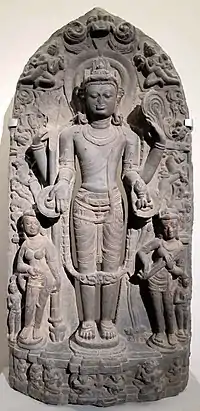
Coinage
In the political history of Bengal, Sena dynasty was a mighty ruling dynasty in power. Various currency names have been regularly mentioned in the Sena writings, such as Purana, Dharan, Dramma. These terms were used to mean a silver coin weighing 32 ratis (56.6 grains) or a karshapan weighing scale. The term Kapardaka Purana is seen as a medium of exchange in the writings of the Sena kings and other contemporary kings. Karpadak means cow; And 'Purana' is definitely a kind of silver coin. The conjunction ‘kapardaka-purana’ refers to a medium of exchange whose quality is equal to that of a purana or silver coin (56.6 grains), but which is actually calculated by the proportional denominator. The table found in the traditional arithmetic of Bengal contained 1260 cowries instead of one silver coin (Purana or Dramma). That is, the ratio of Purana and Kapardaka is 1: 1280. Reliable evidence of the widespread use of cowrie in early medieval Bengal has been found in excavations at Paharpur and Kalgang (Bihar near Bhagalpur). Early medieval Bengal saw the scarcity of precious coins and the widespread circulation of cowries. Scholars have long sought to explain the virtual limitations of coins at this time [16]
Decline
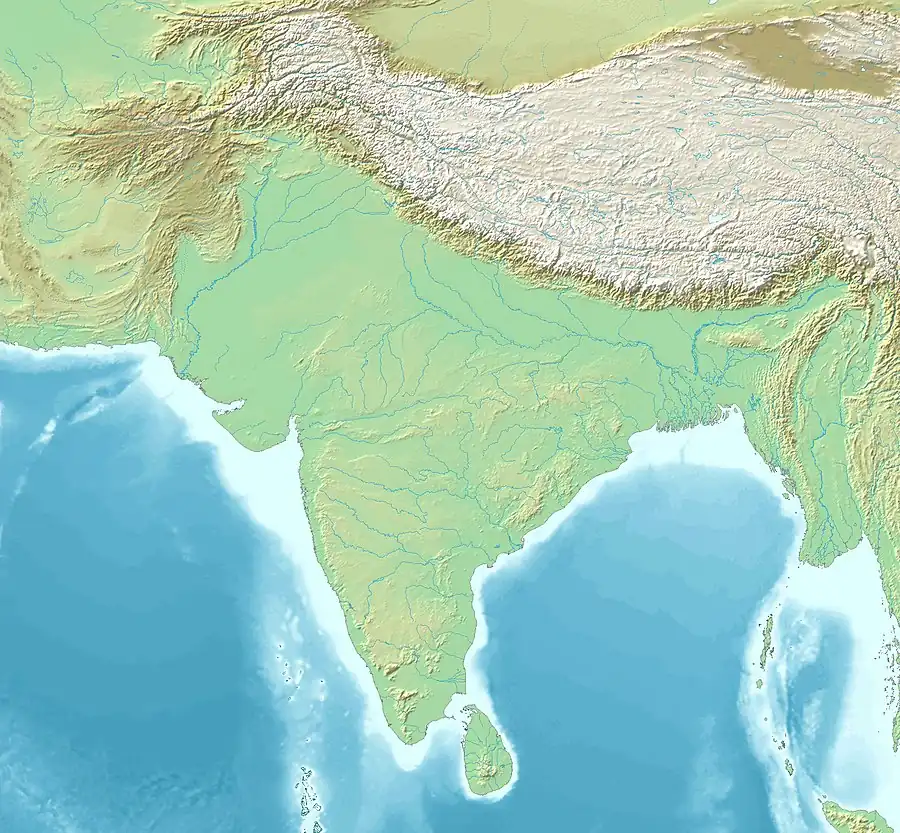
Downfall of Sena dynasty was destined under the rule of weak rulers of this dynasty. This dynasty started declining during the rule of Lakshmanasena who was the last significant Sena king. His two sons Visvarupasena and Kesavasena ruled in succession after him.[19] As Lakshmansena was on the throne in 1205 A. D., his two sons may be regarded as having ruled till at least 1230 A.D.[20] However it was learnt from Tabaqat-i-Nasiri that the descendants of Lakshmansena ruled in Bengal (Bang) till at least 1245 A.D. or 1260 A.D.[20]
Legacy
The Senas and their descendants merged into the Kayastha caste-group, heralding them as the neo-Kshatriyas of Bengal — hence, Abul Fazl would write that Bengal had always been ruled by Kayasthas.[21][22] The actual caste-status of Senas — notwithstanding the anachronism — remain contested in popular memory: premodern Baidya genealogies claim the Senas as their own which are agreed upon by some Brahmin genealogies but rejected by Kayastha ones.[23][24][25][26]
Family tree
| Sena dynasty | |||||||||||||||||||||||||||||||||||||||||||||||||||||||||||||||||||||||||||||||||||||||||||||||||||||||||||||||||||||||||||||||||||||||||||||||||||||||||||||||||||||||||||||||||||||||||||||||||||||||||||||||||||||||||||||||||||||||||||||||||||||||||||||||||||||||||||||||||||||||||||||||||||||||||||||||||||||||||||||||||||||||||||||||||||||||||||||||||||||||||||||||||||||||||||||||||||||||||||||||||||||||||||||||||||||||||||||||||||||||||||||||||||||||||||||||||||||||||||||||||||||||||||||||||||||||||||||||||||||||||||||||||||||||||||||||||||||||||||||||||||||||||||||||||||||||||||||||||||||||||||||||||||||||||||||||||||||||||||||||||||||||||||||||||||||||||||||||||||||||||||||||||||||||||||||||||||||||||||||||||||||||||||||||||||||||||||||||||||||||||||||||||||||||||||||||||||||||||||||||||||||||||||||||||||||||||||||||||||||||||||||||||||||||||||||||
|---|---|---|---|---|---|---|---|---|---|---|---|---|---|---|---|---|---|---|---|---|---|---|---|---|---|---|---|---|---|---|---|---|---|---|---|---|---|---|---|---|---|---|---|---|---|---|---|---|---|---|---|---|---|---|---|---|---|---|---|---|---|---|---|---|---|---|---|---|---|---|---|---|---|---|---|---|---|---|---|---|---|---|---|---|---|---|---|---|---|---|---|---|---|---|---|---|---|---|---|---|---|---|---|---|---|---|---|---|---|---|---|---|---|---|---|---|---|---|---|---|---|---|---|---|---|---|---|---|---|---|---|---|---|---|---|---|---|---|---|---|---|---|---|---|---|---|---|---|---|---|---|---|---|---|---|---|---|---|---|---|---|---|---|---|---|---|---|---|---|---|---|---|---|---|---|---|---|---|---|---|---|---|---|---|---|---|---|---|---|---|---|---|---|---|---|---|---|---|---|---|---|---|---|---|---|---|---|---|---|---|---|---|---|---|---|---|---|---|---|---|---|---|---|---|---|---|---|---|---|---|---|---|---|---|---|---|---|---|---|---|---|---|---|---|---|---|---|---|---|---|---|---|---|---|---|---|---|---|---|---|---|---|---|---|---|---|---|---|---|---|---|---|---|---|---|---|---|---|---|---|---|---|---|---|---|---|---|---|---|---|---|---|---|---|---|---|---|---|---|---|---|---|---|---|---|---|---|---|---|---|---|---|---|---|---|---|---|---|---|---|---|---|---|---|---|---|---|---|---|---|---|---|---|---|---|---|---|---|---|---|---|---|---|---|---|---|---|---|---|---|---|---|---|---|---|---|---|---|---|---|---|---|---|---|---|---|---|---|---|---|---|---|---|---|---|---|---|---|---|---|---|---|---|---|---|---|---|---|---|---|---|---|---|---|---|---|---|---|---|---|---|---|---|---|---|---|---|---|---|---|---|---|---|---|---|---|---|---|---|---|---|---|---|---|---|---|---|---|---|---|---|---|---|---|---|---|---|---|---|---|---|---|---|---|---|---|---|---|---|---|---|---|---|---|---|---|---|---|---|---|---|---|---|---|---|---|---|---|---|---|---|---|---|---|---|---|---|---|---|---|---|---|---|---|---|---|---|---|---|---|---|---|---|---|---|---|---|---|---|---|---|---|---|---|---|---|---|---|---|---|---|---|---|---|---|---|---|---|---|---|---|---|---|---|---|---|---|---|---|---|---|---|---|---|---|---|---|---|---|---|---|---|---|---|---|---|---|---|---|---|---|---|---|---|---|---|---|---|---|---|---|---|---|---|---|---|---|---|---|---|---|---|---|---|---|---|---|---|---|---|---|---|---|---|---|---|---|---|---|---|---|---|---|---|---|---|---|---|---|---|---|---|---|---|---|---|---|---|---|---|---|---|---|---|---|---|---|---|---|---|---|---|---|---|---|---|---|---|---|---|---|---|---|---|---|---|---|---|---|---|---|---|---|---|---|---|---|---|---|---|---|---|---|---|---|---|---|---|---|---|---|---|---|---|---|---|---|---|---|---|---|---|---|---|---|---|---|---|---|---|---|---|---|---|---|---|---|---|---|---|---|---|---|---|---|---|---|---|---|---|---|---|---|---|---|---|---|---|---|---|---|---|---|---|---|---|---|---|---|---|---|---|---|---|---|---|---|---|---|---|---|---|---|---|---|---|---|---|---|---|---|---|---|---|---|---|---|---|---|---|---|---|---|---|---|---|---|---|---|---|---|---|---|---|---|---|---|---|---|---|---|---|---|---|---|---|---|---|---|---|---|---|---|---|---|---|---|---|---|---|---|---|---|---|---|---|---|---|---|---|---|---|---|---|---|---|---|---|---|---|---|---|---|---|---|---|---|---|---|---|---|---|---|---|---|---|---|---|---|---|---|---|---|---|---|---|---|---|---|---|---|---|---|---|---|---|---|---|---|---|---|---|---|---|---|---|---|---|---|---|---|---|---|
| |||||||||||||||||||||||||||||||||||||||||||||||||||||||||||||||||||||||||||||||||||||||||||||||||||||||||||||||||||||||||||||||||||||||||||||||||||||||||||||||||||||||||||||||||||||||||||||||||||||||||||||||||||||||||||||||||||||||||||||||||||||||||||||||||||||||||||||||||||||||||||||||||||||||||||||||||||||||||||||||||||||||||||||||||||||||||||||||||||||||||||||||||||||||||||||||||||||||||||||||||||||||||||||||||||||||||||||||||||||||||||||||||||||||||||||||||||||||||||||||||||||||||||||||||||||||||||||||||||||||||||||||||||||||||||||||||||||||||||||||||||||||||||||||||||||||||||||||||||||||||||||||||||||||||||||||||||||||||||||||||||||||||||||||||||||||||||||||||||||||||||||||||||||||||||||||||||||||||||||||||||||||||||||||||||||||||||||||||||||||||||||||||||||||||||||||||||||||||||||||||||||||||||||||||||||||||||||||||||||||||||||||||||||||||||||||
Literature

The Sena rulers were also great patrons of literature. During the Pala dynasty and the Sena dynasty, major growth in Bengali was witnessed. Among the poets at the court of Lakshmana Sena were:
References
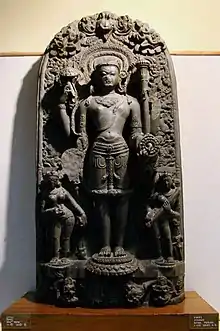
- Schwartzberg, Joseph E. (1978). A Historical Atlas of South Asia. Oxford University Press, Digital South Asia Library. p. 147, Map "f".
- Raj Kumar (2003). Essays on Medieval India. Discovery Publishing House. p. 340. ISBN 9788171416837.
- For a map of their territory, see: Schwartzberg, Joseph E. (1978). A Historical atlas of South Asia. Chicago: University of Chicago Press. p. 147, map XIV.3 (f). ISBN 0226742210.
- The History of the Bengali Language by Bijay Chandra Mazumdar, p. 50.
- Land of Two Rivers: A History of Bengal from the Mahabharata to Mujib by Nitish K. Sengupta, p. 51.
- MAJUMDAR, R. C. THE HISTORY OF BENGAL, VOLUME -I. p. 223.
- Sen, Sailendra Nath (1999). Ancient Indian History and Civilization. New Age International. p. 287. ISBN 978-81-224-1198-0.
- MAJUMDAR, R. C. (1971). HISTORY OF ANCIENT BENGAL. G. BHARADWAJ , CALCUTTA.
- Chopra, Pran Nath (1982). Religions and Communities of India. East-West Publications. p. 78. ISBN 978-0-85692-081-3.
The Sena kings were probably Baidyas. The evidence of inscriptions shows that a dynasty of Baidya kings ruled over at least a part of Bengal from 1010 AD to 1200 AD. The most famous of these kings is Ballal Sena
- Sen, Sailendra (2013). A Textbook of Medieval Indian History. Primus Books. pp. 35–36. ISBN 978-9-38060-734-4.
- Furui, Ryosuke (2 July 2019). "6: Towards Brahmanical Systematisation: c. 1100–1250 AD". Land and Society in Early South Asia: Eastern India 400–1250 AD. Routledge. p. 188. ISBN 978-1-000-08480-1.
- Hunter, William Wilson (1875), "A statistical account of Bengal, Volume 1", Google Books, Edinburgh: Murry and Gibbs, retrieved 3 October 2009
- Siddiq 2015, p. 35.
- Momtazur Rahman Tarafdar, "Itihas O Aitihasik", Bangla Academy Dhaka, 1995
- Mitra, Rajendralala (1865). "On the Sena Rajas of Bengal". Journal of the Asiatic Society of Bengal. Asiatic Society of Bengal. 34 part 1 (3): 141–142.
- "Coins". Banglapedia.
- Schwartzberg, Joseph E. (1978). A Historical atlas of South Asia. Chicago: University of Chicago Press. p. 37, 147. ISBN 0226742210.
- Eaton, Richard M. (25 July 2019). India in the Persianate Age: 1000-1765. Penguin UK. p. 38. ISBN 978-0-14-196655-7.
- Majumdar 1943, p. 225.
- Majumdar 1943, p. 227.
- Andre Wink (1991). Al-Hind, the Making of the Indo-Islamic World, Volume 1. Brill Academic Publishers. p. 269. ISBN 978-90-04-09509-0. Retrieved 3 September 2011.
- Eaton, Richard Maxwell (1996). The Rise of Islam and the Bengal Frontier, 1204–1760. University of California Press. pp. 102–103. ISBN 978-0-52020-507-9.
- Majumdar, R. C.; Ganguly, D. C.; Hazra, R. C. (1943). Majumdar, R. C. (ed.). History Of Bengal. The University of Dacca. pp. 571, 589–591.
- Chatterjee, Kumkum (1 October 2010). "Scribal elites in Sultanate and Mughal Bengal". The Indian Economic & Social History Review. 47 (4): 445–472. doi:10.1177/001946461004700402. ISSN 0019-4646. S2CID 143802267.
- Chatterjee, Kumkum (1 September 2005). "Communities, Kings and Chronicles: The Kulagranthas of Bengal". Studies in History. 21 (2): 173–213. doi:10.1177/025764300502100203. ISSN 0257-6430. S2CID 144413665.
- Sircar, Dineschandra (1971). Studies in the Religious Life of Ancient and Medieval India. Motilal Banarsidass Publ. ISBN 978-81-208-2790-5.
It may be added that the Senas themselves came to be regarded as Vaidyas in the Vaidya Kula-pañjikās.
- R. C. Majumdar, ed. (1943). The History of Bengal. Vol. I. Lohanipur: N. V. Publications. p. 363.
Sources
- Early History of India 3rd and revised edition by Vincent A Smith
- Siddiq, Mohammad Yusuf (2015), Epigraphy and Islamic Culture:Inscriptions of the Early Muslim Rulers of Bengal (1205-1494), Routledge Contemporary South Asia Series
- Majumdar, R. C (1943). History Of Bengal Vol.1.
External links
- Chowdhury, AM (2012). "Sena Dynasty". In Islam, Sirajul; Jamal, Ahmed A. (eds.). Banglapedia: National Encyclopedia of Bangladesh (Second ed.). Asiatic Society of Bangladesh.